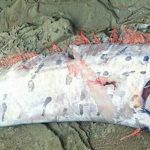Pictures of deformed daisies, possibly by-products of the Fukushima nuclear power plant meltdown, are fast becoming viral. The pictures were taken at Nasushiobara City, located 110 kilometers from Fukushima, and were uploaded by Twitter user @San_kaido with the following caption: (as translated from the Japanese)
“The right one grew up, split into 2 stems to have 2 flowers connected each other, having 4 stems of flower tied belt-like. The left one has 4 stems grew up to be tied to each other and it had the ring-shaped flower…”

Three of Fukushima’s nuclear reactors suffered meltdowns following the devastating earthquake and tsunami that struck the region in March 2011. The daisies are but the latest example of mutated flora and fauna springing up near the area four years after the incident.
A series of articles published in American science magazine, Journal of Heredity, chronicles the widespread impact of the nuclear disaster. Dr. Timothy Mousseau from the University of South Carolina states in one of the articles that “…results from studies of birds, monkeys, butterflies, and other insects suggests that some species have been significantly impacted by the radioactive releases related to the Fukushima disaster.”
Barn swallows found in the area are of particular note, as they are beginning to exhibit mutations similar to barn swallows found near the Chernobyl plant, a nuclear power plant in the Ukraine which suffered a catastrophic meltdown in 1986.
Dr. Mousseau calls for continued studies at Chernobyl as these could predict likely future effects at the Fukushima site. The researcher also adds that “detailed analyses of genetic impacts to natural populations could provide the information needed to predict recovery times for wild communities at Fukushima as well as any sites of future nuclear accidents.” Furthermore, these studies are of vital importance as the findings raise fears over the long-term effects of radiation on people who suffered exposure days and weeks after the disaster.


